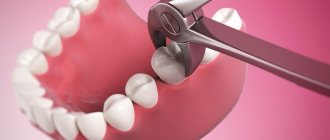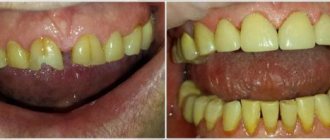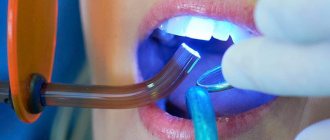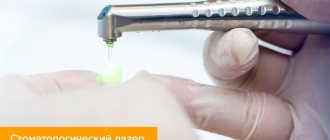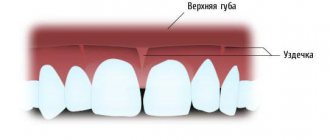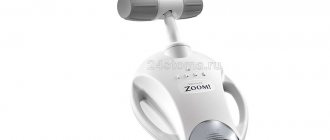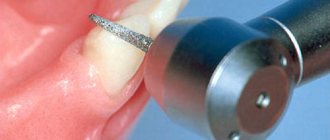Microabrasion is a modern method of combating discoloration on the surface of teeth, which involves carefully grinding off the thinnest layer of damaged enamel using a specialized abrasive composition. The thickness of the ground layer rarely exceeds 60 microns, which avoids the development of dentin hyperesthesia and tooth hypersensitivity. Competent, professional microabrasion helps to achieve the highest aesthetic results and completely eliminate pigmented spots and areas of demineralization on the surface of the enamel layer.
Indications for the procedure
If you are offered microabrasion, then there are probably the following indications for this:
- unsightly and uneven enamel color, stains that could not be removed with the help of professional oral hygiene and for which whitening alone is not enough,
- spotted hypoplasia,
- the initial stage of fluorosis in streaked and spotted forms: for erosive and destructive types of the disease, the procedure is not performed,
- the presence of areas of enamel demineralization: the procedure can be carried out as a caries prevention, as an addition to remineralization or fluoridation,
- white spots and unevenness on the enamel after removing braces.
Clinical researches
ASEPTA products are clinically proven effective. For example, repeated laboratory tests have proven that regular use of preventive toothpaste ASEPTA SENSITIVE for a month can reduce bleeding gums by 62%, reduce sensitivity of teeth and gums by 48% and reduce inflammation by 66%.
Clinical studies have proven that regular use of professional toothpaste ASEPTA REMINERALIZATION improved the condition of the enamel by 64% and reduced tooth sensitivity by 66% after just 4 weeks.
Sources:
- Report on determining/confirming the preventive properties of toothpaste “ASEPTA PLUS” GENTLE WHITENING” Author: doctor-researcher A.A. Leontyev, head Department of Preventive Dentistry, Doctor of Medical Sciences, Professor S.B. Ulitovsky First St. Petersburg State Medical University named after. acad. I.P. Pavlova, Department of Preventive Dentistry
- Clinical and laboratory assessment of the influence of domestic therapeutic and prophylactic toothpaste based on plant extracts on the condition of the oral cavity in patients with simple marginal gingivitis. Doctor of Medical Sciences, Professor Elovikova T.M.1, Candidate of Chemical Sciences, Associate Professor Ermishina E.Yu. 2, Doctor of Technical Sciences Associate Professor Belokonova N.A. 2 Department of Therapeutic Dentistry USMU1, Department of General Chemistry USMU2
- Clinical studies of antisensitive toothpaste “Asepta Sensitive” (A.A. Leontyev, O.V. Kalinina, S.B. Ulitovsky) A.A. LEONTIEV, dentist O.V. KALININA, dentist S.B. ULITOVSKY, Doctor of Medical Sciences, Prof. Department of Therapeutic Dentistry, St. Petersburg State Medical University named after. acad. I.P. Pavlova
- The role of anti-inflammatory rinse in the treatment of periodontal diseases (L.Yu. Orekhova, A.A. Leontyev, S.B. Ulitovsky) L.Yu. OREKHOVA, Doctor of Medical Sciences, Prof., Head of Department; A.A. LEONTIEV, dentist; S.B. ULITOVSKY, Doctor of Medical Sciences, Prof. Department of Therapeutic Dentistry of St. Petersburg State Medical University named after. acad. I. P. Pavlova
- Report on determining/confirming the preventive properties of toothpaste “ASEPTA PLUS” COFFEE and TOBACCO Author: doctor-researcher A.A. Leontyev, head Department of Preventive Dentistry, Doctor of Medical Sciences, Professor S.B. Ulitovsky. First St. Petersburg State Medical University named after. acad. I.P. Pavlova, Department of Preventive Dentistry
- Report on determining/confirming the preventive properties of commercially produced personal oral hygiene products: Asepta toothpaste used in combination with Asepta mouthwash and Asepta gum balm Head. Department of PFS Doctor of Medical Sciences Professor S.B. Ulitovsky St. Petersburg State Medical University named after Academician I.P. Pavlova. Faculty of Dentistry. Department of Preventive Dentistry.
What are the contraindications
Removal of a thin layer of enamel is contraindicated in the following pathologies and conditions:
- severe thinning or destruction of hard tissues (including cracks and chips),
- multiple caries,
- erosion and wedge-shaped defect,
- advanced stages of fluorosis and hypoplasia (including erosive, grooved, mixed),
- bleeding gums and exposure of tooth roots.
The procedure is not performed on baby teeth or on pregnant and lactating women. Microabrasion is not performed on pulpless, that is, nerveless, elements. Its use is inappropriate for such a defect as tetracycline staining, as well as after treatment with resorcinol-formalin compounds.
The microabrasion procedure may have contraindications
Important! The success of microabrasion largely depends on the correct definition of the clinical case. If the treatment method is chosen incorrectly, it can disappoint the patient. After all, the procedure can only eliminate superficial discoloration of the enamel.
Efficiency and safety
Microabrasion allows you to get rid of enamel discoloration. As a result, not only the appearance of the tooth improves, but its further destruction is stopped. In addition, micro-abrasive treatment allows you to avoid tooth grinding and restoration using expensive composites. After the procedure, age spots do not return.
Efficiency depends on the degree of damage: microabrasion helps either completely eliminate surface stains on the enamel or mask discolored areas. Provides a natural glossy shine to the enamel surface. The result is noticeable immediately after the procedure.
The main complication after the procedure is increased tooth sensitivity. To eliminate it, it is recommended to use special toothpastes and rinses for sensitive teeth, for example, low-abrasive ASEPTA Sensitive toothpaste. Additionally, it is necessary to use remotherapy products as an opportunity to mineralize damaged areas, for example, ASEPTA Plus Remineralization. This professional toothpaste restores weakened and damaged enamel, saturates it with essential macro- and microelements.
Features of the method
- Enamel microabrasion is considered a minimally invasive procedure. It is painless and does not require anesthesia. It feels like an Air-flow procedure, polishing a filling or, for example, facial peeling. The result is achieved in 1 session.
- When enamel microabrasion is performed, according to various sources, on average, from 15 to 60 microns of hard tissue are removed, depending on the clinical situation.
- To remove the required thickness, doctors use various gels and suspensions, which may include pumice, hydrochloric acid, and silicon carbide microparticles. The gel is rubbed into the enamel using special brushes and rubber cups.
- After microabrasion, a smooth surface is formed on the enamel that reflects light well, and therefore visually the tooth looks whiter and healthier.
Expert opinion
Elina Ruslanovna Dzagurova
Specializations: Dentist-therapist
Experience: 11+
“To achieve a better effect, microabrasion is often used in the treatment of hypoplasia and other forms of discoloration in addition to other measures: bleaching, remineralization and fluoridation courses, artistic restoration with adhesive materials.”
Stages of the procedure
Regardless of the pathologies for which microabrasion is performed: fluorosis, hypoplasia, or simply pigmentation of the enamel, the essence and order of the procedure does not change.
| Stages | Description |
| First stage | The doctor assesses the condition of hard tissues, visually examines them, and identifies boundaries and areas of discoloration. |
| Second phase | Removing soft and hard plaque from the surface of teeth in order to best prepare them for exposure to abrasive compounds. |
| Third stage | Protection and isolation of the soft tissues of the oral cavity using a rubber dam or rubber dam. |
| Fourth stage | Applying an abrasive mass, rubbing it into the enamel using rubber cups, which are set to rotate slowly. The procedure lasts about 30-60 seconds. |
| Fifth stage | Rinsing the tooth with a water-air spray. The decision to re-use abrasives (for better effect, the procedure can be repeated 2-3 times at intervals of 60 seconds). |
| Sixth stage | Strengthening enamel using a remineralizing gel or fluoridated prophylactic composition. |
“While wearing braces, white spots appeared on my teeth. This became especially noticeable after removing the plates. To be honest, at first I was very upset, because even though my teeth were straight, these stains were not at all what I expected to see as a result of long-term treatment. I thought I'd have to bleach it. But the doctor suggested a better solution - microabrasion. In principle, after this, the teeth began to look very good, and those around them generally thought that they were perfect. So I recommend it!”
Orange, review from woman.ru
Prevention of fluorosis
To prevent the development of fluorosis in children living in a risk zone, it is necessary to transfer the newborn from breastfeeding to complementary feeding as late as possible; in the future, it is necessary to provide the child with a balanced diet, and, if possible, replace water with milk.
Additional intake of calcium and phosphorus will also help to avoid fluoride oversaturation, since it is these microelements that help remove it from the body. It will be useful to send your child on vacation to various health camps, to visit relatives in other regions, in order to temporarily change the water source. Toothpaste, rinses and flosses for the oral cavity for fluorosis and for its prevention should be chosen without fluoride compounds. It is especially important to exclude the use of fluoride toothpastes in children, since children do not yet know how to brush their teeth properly and swallow part of the toothpaste.
Fluorosis is a disease of the skeletal system and teeth, which can be acquired at any age. But the main risk of development still occurs in the period before the eruption of permanent teeth. All preventive measures will be 100% effective until the enamel of molar teeth in children is fully formed.
Advantages of the method
The procedure is simple to perform and can be used on permanent teeth in adults and adolescents (which cannot be said about whitening). In case of superficial enamel discoloration, microabrasion allows you to quickly and painlessly achieve good results, making your teeth aesthetically more attractive, white and shiny. Another advantage is that the procedure, if the tooth is intact and has not undergone severe destruction, helps to avoid more invasive intervention and refuse the installation of orthopedic structures. For example, crowns.
Before and after the operation
A number of studies suggest that hard tissues subjected to microabrasion are less susceptible to demineralization processes than those that were not treated. They show less colonization of carious bacteria, the main causative agents of caries - Streptococcus mutans.
Dental fluorosis
Fluorosis, or chalky speckled enamel, is a disease that occurs due to prolonged intake of a large dose of fluoride into the body. The content of this microelement in bones is affected by the composition of drinking water. Fluoride is also found in food and even in toothpastes, but from there it is absorbed much worse than fluorides found in water. Therefore, fluorosis is endemic, that is, it is a disease characteristic of a certain area where the water is oversaturated with fluoride. There is also occupational fluorosis - it occurs in workers of enterprises where the content of fluoride compounds in the air is exceeded. However, this type of disease is not very common among the population.
The most susceptible to endemic fluorosis are children and adolescents whose permanent teeth have not yet erupted or whose enamel has not yet strengthened. The daily need for fluoride at this age is 2–3 mg, which the child receives from food and water. For the development of the disease, the maximum permissible concentration of fluoride in water – 1.5 mg/l – will be sufficient. Adults with already formed tooth enamel, even with prolonged use of such water, will not get fluorosis, since the daily norm is already 4 mg. However, if the fluoride content exceeds 6 mg/l, then the teeth of the adult population are also affected. You can find out about the fluoride content in the water in your region by calling the nearest branch of the Sanitary and Epidemiological Station.
Attention!
A fluoride concentration in water of less than 1.5 mg/l also leaves 10–30% of the population at risk of developing fluorosis.
